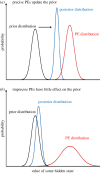'Bodily precision': a predictive coding account of individual differences in interoceptive accuracy
- PMID: 28080962
- PMCID: PMC5062093
- DOI: 10.1098/rstb.2016.0003
'Bodily precision': a predictive coding account of individual differences in interoceptive accuracy
Abstract
Individuals differ in their awareness of afferent information from within their bodies, which is typically assessed by a heartbeat perception measure of 'interoceptive accuracy' (IAcc). Neural and behavioural correlates of this trait have been investigated, but a theoretical explanation has yet to be presented. Building on recent models that describe interoception within the free energy/predictive coding framework, this paper applies similar principles to IAcc, proposing that individual differences in IAcc depend on 'precision' in interoceptive systems, i.e. the relative weight accorded to 'prior' representations and 'prediction errors' (that part of incoming interoceptive sensation not accounted for by priors), at various levels within the cortical hierarchy and between modalities. Attention has the effect of optimizing precision both within and between sensory modalities. Our central assumption is that people with high IAcc are able, with attention, to prioritize interoception over other sensory modalities and can thus adjust the relative precision of their interoceptive priors and prediction errors, where appropriate, given their personal history. This characterization explains key findings within the interoception literature; links results previously seen as unrelated or contradictory; and may have important implications for understanding cognitive, behavioural and psychopathological consequences of both high and low interoceptive awareness.This article is part of the themed issue 'Interoception beyond homeostasis: affect, cognition and mental health'.
Keywords: free energy; heartbeat perception; interoception; interoceptive accuracy; predictive coding.
© 2016 The Author(s).
Figures


References
-
- Ádám G. 2010. Visceral perception. New York, NY: Plenum Press.
-
- Fotopoulou A. 2013. Beyond the reward principle: consciousness as precision seeking. Neuropsychoanalysis 15, 33–38. (10.1080/15294145.2013.10773715) - DOI
Publication types
MeSH terms
Grants and funding
LinkOut - more resources
Full Text Sources
Other Literature Sources

